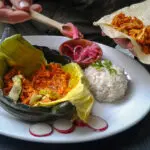Every September, Mexico beats differently. Streets fill with flags, lights in the colors of the Mexican flag, and stalls selling everything from noisemakers to sombreros. The air carries the scent of pozole, pambazos, esquites, and of course, the long-awaited chiles en nogada. It’s the month when the entire country celebrates its Independence, and when one of the most Mexican phrases echoes with pride and identity: “¡Viva México, cabrones!”
More than just a shout, it’s a reminder of who we are: a people who celebrate with intensity, who honor their history, and who make food an essential part of their identity.
El grito de Indepencia: from history to the voice of the people
At dawn on September 16, 1810, Miguel Hidalgo y Costilla launched El grito de Independencia, igniting the War of Independence. Although he never said “Viva México!”, his call to rise against oppression marked a turning point in the nation’s history.
👉 Fun fact: Hidalgo wasn’t only a political and religious leader; he was also passionate about agriculture. He promoted grape cultivation and the production of wine and mezcal both banned by the Spanish Crown. His defiance extended to the table, foreshadowing how in Mexico, freedom and food would always be linked.
Over time, the people made El grito their own, transforming it into expressions of identity like “¡Viva México, cabrones!” a phrase popularized by Pancho Villa in the 20th century, and one that today is heard in every toast, every street, and every Independence Day party.
👉 If you want to experience the heart of Mexico City’s Historic Center through its flavors, join our Historic center Food Tour

September 15th and 16th in Mexico City
On the night of September 15, the Zócalo becomes a sea of people waiting for the president to deliver the cry from the balcony of the National Palace. It’s a massive celebration, with fireworks, mariachi, and thousands of voices shouting names like Hidalgo, Morelos, and Allende.
On September 16, the mood shifts with the military parade along Paseo de la Reforma: planes flying overhead, armored vehicles, marching soldiers, and martial music that stops the city in its tracks. For both locals and visitors, it’s one of the most recommended things to do in Mexico City during September.
👉 Complete your celebration with flavors on our Roma Food Tour.
Chiles en nogada: a dish that evolves with Mexico
If one dish represents Independence celebrations, it’s the chile en nogada. Born in Puebla in 1821, it was created by Augustinian nuns of the Santa Mónica convent to celebrate Agustín de Iturbide’s triumphant arrival after the signing of the Plan of Iguala. Its symbolism is clear: green, white, and red, just like the newly created national flag.
👉 In Coyoacán, one of Mexico City’s most traditional neighborhoods, you can also taste history on our Coyoacán Food Tour.
A roasted poblano is filled with a picadillo that blends beef, pork, and seasonal fruits, panochera apple, lechera pear, criollo peach, then topped with a creamy walnut sauce made of Castilian nuts, queso fresco, and sherry. Finally, parsley and pomegranate crown it in patriotic colors.
👉 Did you know? One traditional ingredient was acitrón, a crystallized candy made from the biznaga cactus. Due to overharvesting, the species became endangered and has been protected by law since 2021. Today, acitrón is replaced with candied fruits, showing how tradition also adapts to protect the environment.
Over time, chiles en nogada have proven their ability to reinvent themselves: lighter, un-battered versions; sweet or salty walnut sauces, depending on the family; even vegan adaptations using mushrooms, quinoa, or legumes.
The fascinating part? Although everyone claims to have the “authentic recipe,” the truth is there are as many versions as there are cooks. Each table makes it a matter of pride and debate battered or not? sweet or savory? with sherry or without? That’s precisely why it’s the perfect emblem of Mexican cuisine: diverse, alive, and open to reinvention.
👉 In Mexico City, one of the most recommended spots to try it is Testal, in the Historic Center, where each year they serve a carefully prepared version that honors tradition while embracing the richness and flexibility of the dish.
From El Grito to Mexico’s most powerful food season
What’s fascinating about Mexico is that September 16 doesn’t mark the end of the party it’s just the beginning of the country’s most powerful food season, one that extends until January:
- Guadalupe–Reyes (December–January): the most Mexican “marathon” of all. Posadas, Christmas, and Three Kings’ Day with ponche made of sugarcane and tejocote, roasted turkey, romeritos in mole, bacalao, and of course, the Rosca de Reyes.
👉 Looking to organize a culinary experience for your team or company? Sabores México is your best option. - Day of the Dead (November): altars covered with marigolds, candles, and pan de muerto. Since 2008, this tradition has been recognized by UNESCO as Intangible Cultural Heritage of Humanity.
👉 Our markets fill with marigolds and altar decorations, experience it on our Jamaica Market Tour. - La Noche de las Ánimas: a five-course dinner inspired by the different underworlds, blending pre-Hispanic and contemporary flavors. An exclusive Sabores México experience, returning for its third edition in 2025.
👉 Reserve your seat for this unique event: Noche de las Ánimas.
Gastronomy, tourism, and pride
From September to January, the Mexican table becomes a bridge between history and celebration. Few countries can claim their cuisine tells as much about their identity as Mexico’s does.
For travelers, foodies, and locals alike, it’s the perfect season to:
-Stroll through modern neighborhoods like Roma on a food tour.
-Connect with tradition in a culinary journey through Coyoacán.
-Discover the local life and colors of the Jamaica Market Tour.
Independence Day in Mexico is much more than a historic remembrance, it’s a living cycle of celebrations where food and national pride go hand in hand.
From shouting “¡Viva México, cabrones!” in a plaza to savoring a chile en nogada in the Historic Center, from pan de muerto to ponche and the Rosca de Reyes, every bite is a way of understanding what it means to be Mexican or to feel part of Mexico, even if only for a few days.
Because here, the party is served at the table.
¡Viva México, cabrones!



